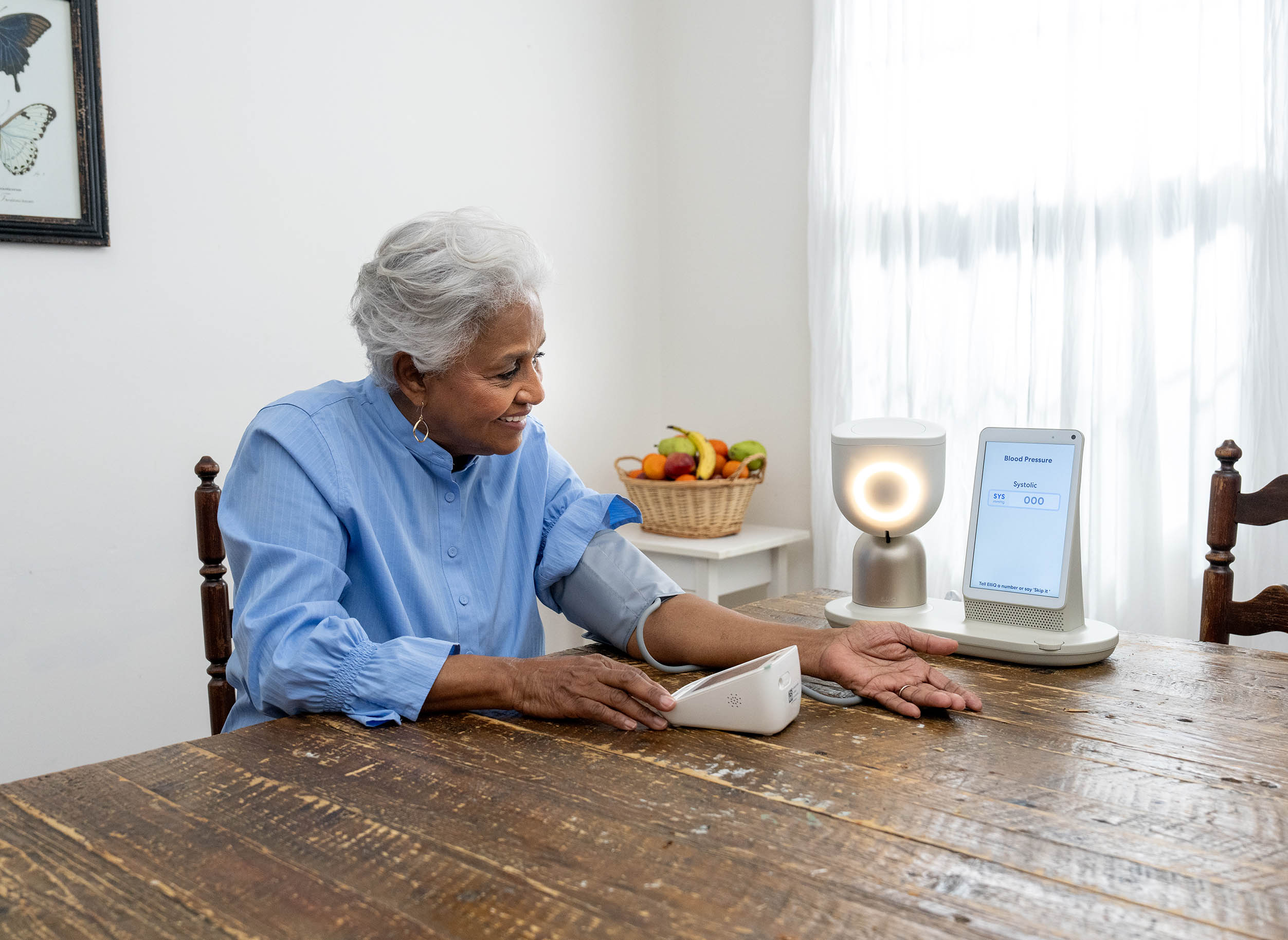Will a AI Take Care of You in Old Age?
AI may be just the help older adults and their caretakers need. Just don't expect it to be a cute little humanoid — yet.


Maybe it starts with a missed bill.
Or dirty dishes in the sink.
Or a growing dread of leaving the house.
From just $107.88 $24.99 for Kiplinger Personal Finance
Become a smarter, better informed investor. Subscribe from just $107.88 $24.99, plus get up to 4 Special Issues

Sign up for Kiplinger’s Free Newsletters
Profit and prosper with the best of expert advice on investing, taxes, retirement, personal finance and more - straight to your e-mail.
Profit and prosper with the best of expert advice - straight to your e-mail.
These are some of the common signs health professionals say indicate a need for care. It’s also a growing reality for people as we live longer. But with rising caregiving costs and a national shortage of caregivers, the question is shifting from “who will care for me when I’m old?” to “what will care for me?”
Consider nearly half of U.S. states (48%) are on the brink of an unpaid family caregiving emergency, according to Columbia University’s Mailman School of Public Health. The U.S. will need an estimated 4.2 million new home care workers by 2026, a gap that won’t be easily filled.
Two in five U.S. adults are now family caregivers, and nearly all face financial strain and burnout, research from Edward Jones finds.
This is where artificial intelligence (AI) is stepping in. While older adults are often excluded from AI design, caregiving is one exception. AI-driven products aim to keep older people connected, enhance health monitoring and help them remain independent.
But can these technologies live up to their promises — and what about the risks? Should you start preparing for a future that might include a robot sidekick?
How AI is transforming caregiving
Imagine being alone at home, engrossed in a book. Suddenly, a voice calls from across the room: it’s a reminder to take your medication. What could have been a dangerous oversight now becomes a simple conversation.
A tabletop AI companion
That’s one of the capabilities of ElliQ, an AI companion robot designed to engage older adults and track their well-being. The system's "face" lights up, moves and speaks to the user in a way that feels almost human.
“We hear from families every day that ElliQ is helping their loved ones feel more connected and less alone,” an Intuition Robotics company representative says. “Users interact with ElliQ on average more than 30 times a day, with 90% saying it reduces their loneliness and 95% reporting improved wellness.”
Makers of these AI companions hope not only to extend care when loved ones can’t be there and provide families with real-time insights, but also to make care more affordable and accessible.
As the company notes, paid human caregivers typically cost about $30 an hour, while AI companions cost just $0.30 an hour. “That means 100 older adults can be offered assistance for the cost of supporting one.”

Hybrid AI and human caregiving
Combatting loneliness and spotting early cognitive decline are two of AI’s biggest current opportunities.
“Being above 65 and lonely is worse for you than smoking 15 cigarettes a day, in terms of premature death risk,” explains Neal Shah, CEO of CareYaya. This nonprofit tech startup connects families with trained student caregivers and is launching AI applications to complement human care.
For instance, it offers a phone-based AI companion that uses language models fine-tuned for older adults to help boost mood and identify red flags in mental health or memory, prompting human follow-up.
The company has also developed tools designed to relieve caregiving stress by automating administrative tasks such as managing insurance claims — work that consumes an average of 13 hours a month for family caregivers, Shah notes.
Training is another promising area, as most family caregivers receive less than two hours of formal training. AI-driven micro-learning apps can now deliver quick, personalized instructions.
Looking ahead, Shah envisions AI companions that could read facial expressions or gait changes to trigger human intervention, as well as real-time translation tools to bridge cultural and language gaps in caregiving.
More options for AI companions
There are several additional for-profit companies offering AI companionship over the phone or other hardware. These programs engage seniors in conversations about their lives, ask follow-up questions and make suggestions for solving problems. They recall past conversations and may be able to help schedule medications.
Meela is a personalized AI voice companion that costs about $40 per month. Meela does not require any hardware other than a phone.
ONSCREEN calls seniors to combat loneliness, but also offers video engagement by accessing a user's television or tablet. Pricing depends on the service you select. The service is only offered in English.
Grandpad is a tablet with large icons and programs designed for seniors. This hardware solution garners mostly positive reviews from Senior Living.
These are just a few options available now for senior companionship and care. If you are ordering for a loved one, be sure to try the system out yourself and check for privacy controls. Someone with mild dementia may be able to use many of these options, whereas someone with more advanced dementia might be limited to answering a phone call. If you're unsure what service would work for a loved one, ask a geriatric social worker for advice.
The limits and risks of AI and AI companions
While the potential is exciting, experts caution against seeing AI as a cure-all.
Human connection
“Our research shows that digital and AI-driven companions can play a positive role by offering opportunities for engagement,” says Dr. Barbara Barbosa Neves, sociologist of aging and technology at the University of Sydney. But, she says, “Social connection and well-being in later life aren’t one-size-fits-all. They require a mix of approaches, tailored to the diverse needs, aspirations, life experiences and capabilities of older adults.”
Many older adults, she adds, are concerned that relying on AI could reduce time spent with loved ones and deepen feelings of detachment. Some have described AI companions as patronizing or infantilizing, a way for society to sideline and forget about them.
“AI may facilitate contact, but it doesn’t always support meaningful relationships that address loneliness,” she explains. “For some older people, especially those experiencing prolonged loneliness, technology can only go so far. In some cases, it may make people feel lonelier and more isolated.”
AI Bias
Another concern is algorithmic bias. Many AI systems are built without sufficient representation of older adults, leading to tools that misinterpret their needs or exclude them entirely, Dr. Neves says.
Focus on areas where AI excels
Ultimately, Dr. Neves warns against “techno-solutionism” — the belief that technology in isolation can fix every problem. “Aging is a natural part of life — a sign that we’re alive — not a problem to be solved!”
Shah offers a grounded perspective, viewing AI as a tool to support, not supplant, human caregiving. “Think of AI as your co-pilot, not the captain,” he says. “AI excels at scalable tasks — reminders, paperwork, conversation. Human caregivers excel at empathy, touch and complex judgment.”
How to plan for your future caregiving needs today
Whether caregiving becomes more tech-driven or remains a largely human effort, one thing is certain: planning for potential care needs is critical.
“Healthcare and long-term care costs pose one of the most serious risks to retirement security,” says David Rosenstrock, financial advisor at Wharton Wealth Planning. A couple with high drug costs may need about $325,000 saved by age 65 to cover health care expenses in retirement.
He suggests, “Health Savings Accounts (HSAs) can be a great and flexible way to plan for future health expenses, if you start early and contribute systematically.”
Long-term care insurance may also be worth considering, says advisor and CFP® Catherine Valega of Green Bee Advisory. “The new policies leverage your insurance dollars for long-term care expenses, and if unused, your heirs receive a death benefit.”
When using AI tools, data security is another key concern. Shah encourages families to ask vendors where data is stored and who can audit their models.
Finally, don’t overlook family conversations. Jessica McNamee, wealth management advisor and founder of Sirius Wealth Strategies, says: “The most common mistake I see is not asking aging parents or family members what role they expect others to play in their care. It is so important to open the lines of communication between generations.”
That’s because caregiving, no matter how burdensome, remains deeply meaningful. In fact, 80% of family caregivers say the role has strengthened their relationships with loved ones, with most reporting feelings of personal fulfillment and gratitude.
And it’s unlikely to change, no matter how advanced AI becomes. “I think even the best AI will remain just tools,” Shah says. “The heart of caregiving is still a reassuring human touch, eye contact and the dignity of being heard by another person.”
So even if technology makes caregiving easier, it won’t make it any less human.
Read More
- Dementia Hot Spots: Is Your Region Raising Your Risk?
- The Average Cost of Health Care by Age
- Eight Changes to HSAs in the One Big Beautiful Bill Add up for Retirement Savers
- The 'First Year of Retirement' Rule
Profit and prosper with the best of Kiplinger's advice on investing, taxes, retirement, personal finance and much more. Delivered daily. Enter your email in the box and click Sign Me Up.

Jacob Schroeder is a financial writer covering topics related to personal finance and retirement. Over the course of a decade in the financial services industry, he has written materials to educate people on saving, investing and life in retirement.
With the love of telling a good story, his work has appeared in publications including Yahoo Finance, Wealth Management magazine, The Detroit News and, as a short-story writer, various literary journals. He is also the creator of the finance newsletter The Root of All (https://rootofall.substack.com/), exploring how money shapes the world around us. Drawing from research and personal experiences, he relates lessons that readers can apply to make more informed financial decisions and live happier lives.
-
 December Fed Meeting: Live Updates and Commentary
December Fed Meeting: Live Updates and CommentaryThe December Fed meeting is one of the last key economic events of 2025, with Wall Street closely watching what Chair Powell & Co. will do about interest rates.
-
 This Is Why Investors Shouldn't Romanticize Bitcoin
This Is Why Investors Shouldn't Romanticize BitcoinInvestors should treat bitcoin as the high-risk asset it is. A look at the data indicates a small portfolio allocation for most investors would be the safest.
-
 I'm a Federal Benefits Pro: I Answer These 2 Questions a Lot
I'm a Federal Benefits Pro: I Answer These 2 Questions a LotMany federal employees ask about rolling a TSP into an IRA and parsing options for survivor benefits, both especially critical topics.
-
 I'm a Financial Pro Focused on Federal Benefits: These Are the 2 Questions I Answer a Lot
I'm a Financial Pro Focused on Federal Benefits: These Are the 2 Questions I Answer a LotMany federal employees ask about rolling a TSP into an IRA and parsing options for survivor benefits, both especially critical topics.
-
 I Retired at 63 to Enjoy My Free Time but My Grown Kids Want Help With Childcare. I Love My Grandkids but It's Too Much. What Should I Do?
I Retired at 63 to Enjoy My Free Time but My Grown Kids Want Help With Childcare. I Love My Grandkids but It's Too Much. What Should I Do?We asked therapists and relationship experts for advice.
-
 5 RMD Mistakes That Could Cost You Big-Time: Even Seasoned Retirees Slip Up
5 RMD Mistakes That Could Cost You Big-Time: Even Seasoned Retirees Slip UpThe five biggest RMD mistakes retirees make show that tax-smart retirement planning should start well before you hit the age your first RMD is due.
-
 I'm a Wealth Adviser: My 4 Guiding Principles Could Help You Plan for Retirement Whether You Have $10,000 or $10 Million
I'm a Wealth Adviser: My 4 Guiding Principles Could Help You Plan for Retirement Whether You Have $10,000 or $10 MillionRegardless of your net worth, you deserve a detailed retirement plan backed by a solid understanding of your finances.
-
 A Retirement Triple Play: These 3 Tax Breaks Could Lower Your 2026 Bill
A Retirement Triple Play: These 3 Tax Breaks Could Lower Your 2026 BillGood news for older taxpayers: Standard deductions are higher, there's a temporary 'bonus deduction' for older folks, and income thresholds have been raised.
-
 10 New Year's Resolutions for Retiring Next Year
10 New Year's Resolutions for Retiring Next YearThese New Year's resolutions will help you retire in 2026 with confidence in your financial strategy.
-
 Think You Know How to Be Happy in Retirement? These 9 Stats May Surprise You
Think You Know How to Be Happy in Retirement? These 9 Stats May Surprise YouWhen it comes to your retirement happiness, don't believe everything you hear. We've turned to solid research for the facts on finding your bliss in retirement.
-
 If You're Retired or Soon-to-Be Retired, You Won't Want to Miss Out on These 3 OBBB Tax Breaks
If You're Retired or Soon-to-Be Retired, You Won't Want to Miss Out on These 3 OBBB Tax BreaksThe OBBB offers some tax advantages that are particularly beneficial for retirees and near-retirees. But they're available for only a limited time.